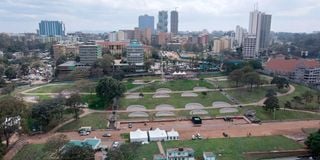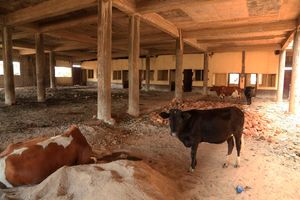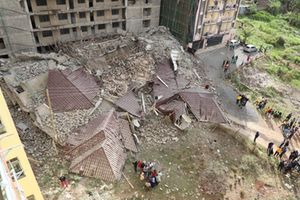Nairobi’s troubled trek to become green

An aerial view of Uhuru Park that now boasts manicured lawns, enhanced walkways and green spaces.
What you need to know:
- The city has blundered by failing to exploit low-hanging fruits for sustainability for years, putting in doubt its desire and sincerity to become an African leader in greenness.
- At times, it has appeared like a city hung up on its captive, dirty past.
As the world converges in Sharm-el-Sheikh, Egypt to discuss ways to combat climate change, discussions on how to make cities greener and sustainable have featured heavily.
From waste management to e-mobility, public gardens and clean energy, every discussion here has highlighted the difficult but doable job that faces Nairobi in its quest for sustainability.
In the last 10 years, Kenya’s capital has had an impressive record in its attempts to become green, smart and sustainable. From innovative building designs to adoption of e-mobility and clean energy, the city has, arguably, set itself apart from its continental peers.
But if Nairobi were participating in a sprint to become green, it would be a case of moving 50 metres toward the finish line at a blistering speed before turning to run 30 metres in the opposite direction. The city has blundered by failing to exploit low-hanging fruits for sustainability for years, putting in doubt its desire and sincerity to become an African leader in greenness. At times, it has appeared like a city hung up on its captive, dirty past.
Greening a city, though, has no plug and play solutions. Rather, it is a complex process as Divyata Ashiya admits. ‘‘It is a global issue and a collective responsibility to make strategies work,’’ says Ashiya, a partner at Just Transition Capital, on the sidelines of COP27 in Sharm-el-Sheikh.
Public transport
A grossly inefficient public transport, consistent loss of green spaces, wanton destruction of public parks and pathetic housing conditions for its five million inhabitants mirror the struggle the city is undergoing in the long trek to sustainability. While countries such as Denmark buy waste from their neighbours Sweden and Germany to recycle, earning revenues running into millions of Euros annually, Nairobi is barely able to recycle its daily waste output of about 2,400 tonnes.
For weeks now, Kenyans on Twitter have been calling out the county government to deal with rotting garbage in the city’s suburbs, with minimal response. Three months since Governor Johnson Sakaja was sworn into office, the old order of illegal dumping of garbage and the litter going uncollected for days as broke sewer lines soak streets unattended still reigns. In the city estates of Pipeline, Korogocho and Mathare, residents live in dehumanising conditions.
Some are now decrying discrimination. ‘‘This would not happen in some neighbourhoods in Nairobi,’’ says a Twitter user.
Sakaja is now proposing a law to fine those found littering the streets. ‘‘We will arrest, prosecute and split the fine.’’ Elsewhere, punitive fines have worked to deter littering. In the Egyptian municipality of Sharm-el-Sheikh, for instance, littering attracts a fine of 500,000 Egyptian pounds (Sh2.4 million). Urban planner and researcher Edwin Kabugi proposes the circular economic model as the solution for waste management in Nairobi, noting, ‘‘We need to maximise the use of our waste as a raw material for our development process.’’
The story of waste water management in the city is another tragedy. One hundred years later, only half of Nairobi is connected to the sewage infrastructure. Whether the system is reliable is a different conversation altogether. In the last two years, the government and its development partners, the African Development Bank and the French Development Agency, have invested nearly Sh3 billion to repair and expand the city’s sanitation infrastructure, with a target of 72 per cent coverage by 2025. It is a long journey that could finally rid Nairobi of rivulets of filth that characterise its neighbourhoods.
John Michuki Memorial Park is perhaps the biggest win in Nairobi’s journey of restoring green spaces in recent years. The green park offers residents tranquillity in a city known for ruckus and chaos. This win has, however, coincided with the loss of a section of Uhuru Park – Kenya’s most popular ground – to Green Park bus terminus and a section of the Nairobi Expressway.
In a city that hosts seven million people every day, only four other parks, namely Arboretum, City Park, Karura Forest and Gevanjee Gardens, exist.
But after years of neglect, Gevanjee Gardens is now a plot of red earth and dying vegetation. Minimal efforts to maintain its greenery and infrastructure have turned the facility that hosts hundreds of Kenyans daily into a square for the city’s cons, gamblers and idlers.
So, why it is important for a city to be green? Kabugi says this goes beyond serving aesthetics purposes to perform ecological functions such as preservation of resources and their efficient use at a time of shortage.
“Urban development is heavily taxing on the environment through sourcing for material. Designers should endeavour to employ especially nature-based solutions to meet these functions,’’ says the Belgium-based urban planner.
He adds: ‘‘Greening our city forms a solid basis for protection of our biodiversity. Accessibility of green spaces is also good for cohesion for Nairobi’s richly diverse populace.’’
The installation of walkways in the city centre in the last two years has not only eased movement and safety of pedestrians but beautified the city as well. Even so, large sections of Nairobi have yet to install these pavements and people on foot still have to contend dangerously for space with vehicles and motorbikes.
The city may be attracting electric buses by the day, but only a handful of them are available to move the city. Meanwhile, personal vehicles and matatus jam the roads, causing inconvenience and polluting the environment in a city where properly cycling lanes remain a pipedream.
The designer says Nairobi’s plans to become green should go hand in hand with deliberate efforts to replace fossil fuels with renewable energy forms. ‘‘This way, we will attain energy efficiency in production, consumption and release.’’
Few utilities highlight the divide between the poor and the rich in Nairobi quite like housing. There are neighbourhoods for the rich and others for the city’s poorest people. Experts say mixed-use development and integration of the wealthy and the economically disadvantaged in housing could be the surest way to create equality and sustainability.
World cities such as Copenhagen have isolated some of their municipalities for this type of development, allowing the rich and poor to enjoy the same amenities for the same quality of life. Some argue that by coming up with the affordable housing project, the government has made the step towards attaining quality housing for all.
As climate change escalates and the world warms up, architects are having to develop innovative building designs that feature greenness to make them resilient. This means having them run on green energy such as solar and incorporation of plants on roofs, walls and balconies. This creates an aesthetic effect while cooling the building.
‘‘The road to becoming green starts with reduced energy consumption. Greening the city would reduce the urban heat island effect, consequently reducing the need for cooling and, therefore, cut down our energy consumption.’’
Multiple research findings show that green spaces and plant life have a positive psychological effect on dwellers, by calming and keeping them happy.
Nairobi’s Global Trading Centre best illustrates a green building. The edifice in Westlands features multiple floors of greenery and also offers a panoramic view of the city and its environs.
But even with such new developments, the city has continued to attract non-green buildings and concrete towers with minimal sustainability components that constitute the bulk of the city’s structures.





